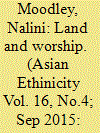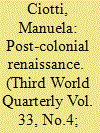| Srl | Item |
| 1 |
ID:
141164


|
|
|
|
|
| Summary/Abstract |
This article, drawn from my doctoral study, focuses on the landscape paintings of two South African graduates of the former Indian institution, the University of Durban-Westville. The work is analysed through the lens of Hindu philosophy and Hindu ritualistic practice which views the earth as fundamental for survival and intrinsically linked to the cosmic order. This article presents the Hindu attachment to the land seen in the expansive imagery of Hindu deities located within serene landscapes resplendent in its attention to mythological and symbolic details. This attachment positions Hinduism as a guide to the exploration of the paintings. This article locates the work within the complex historical base of Indians in South Africa, and the impact it had on contemporary artists of Indian ancestry. While their art production addresses their conflating Indian/South Africanness, their paintings can be viewed as a veiled historiography of the Indian presence in South Africa.
|
|
|
|
|
|
|
|
|
|
|
|
|
|
|
|
| 2 |
ID:
113096


|
|
|
|
|
| Publication |
2012.
|
| Summary/Abstract |
Arjun Appadurai has argued that 'the materiality of objects in India is not yet completely penetrated by the logic of the market'.1
However, the entry and the visibility of modern and contemporary Indian art into the circuits of the global art world increasingly challenge this argument. The story of modern and contemporary Indian art is one of the inscription of local objects and their 'Indianness' into the above circuits, with market value being created inthe process. If the globalisation of the art world provides a conceptual and material arena where objects are circulated, displayed and bought and sold through auction houses, exhibitions, biennales and art fairs, this article analyses an event that epitomises some of the forces at play in this arena: the contemporary art exhibition 'The Empire Strikes Back: Indian Art Today' held in 2010 at the Saatchi Gallery, London. An artistic cum business instantiation of 'India in Europe'-and one that challenges the visual and aesthetic canons 'traditionally' associated with India-this article examines this exhibition as anentry point into the analysis of how neoliberal capital produces 'culture', and into the tension between the commodity form and the infinite possibilities, and unintended consequences, opened up by this very status.
|
|
|
|
|
|
|
|
|
|
|
|
|
|
|
|